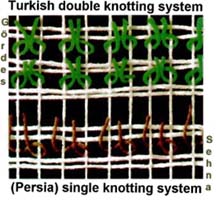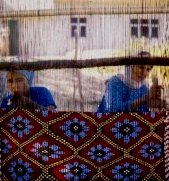|
 There are two principal types of knots
that are used in rug weaving. The first one is called double knot, Turkish
knot, or Gordes knot and naturally given a firmer weave yielding to a
stronger and more durable carpet. The second one is known as the single
knot, Persian knot, or Sennah knot. The Turkish knot is standart of yarn
encirling two warp threads, with the loose ends rawn tightly between the
two warps. The Persian knot is a strand of yarn that encircles one warp
threads and winds loosely around the other warp. One loose end pulled
through the two warps, while the other end goes to the outside of the
paired warps. There are two principal types of knots
that are used in rug weaving. The first one is called double knot, Turkish
knot, or Gordes knot and naturally given a firmer weave yielding to a
stronger and more durable carpet. The second one is known as the single
knot, Persian knot, or Sennah knot. The Turkish knot is standart of yarn
encirling two warp threads, with the loose ends rawn tightly between the
two warps. The Persian knot is a strand of yarn that encircles one warp
threads and winds loosely around the other warp. One loose end pulled
through the two warps, while the other end goes to the outside of the
paired warps.
In flatweaving there are a number of different types of loom and weaving
techniques but for purposes here in, the various types can be categorized
into two general groups. The first grouping contains the basic flat weave
technique, or "kilim weaving". In a kilim, the pattern is formed by passing
a yarn of a particular colour over and over and under the vertical yarns
(known as warps) for the duration of the particular colour or design motif,
then the same horizontal yarn (known as weft) is turned on the same path
(next row) along the edge of the same coloured motif.
This process is continued until the individual motif is completed. Then
the next motif is started where the initial one finishes, but the two
yarn colours are not normally joined together in anyway, thus causing
a slit to appear between the two respective yarns. Each block of colour
is then woven succesively until the whole kilim is completed. When you
hold a kilim woven in this way up to the light, you can easily see the
slits where two patterns meet but do not join. The second grouping contains
flatweaves which employ the technique of way wrapping or brocading.
A motif is created by adding a third yarn to the warp and weft yarns which
is wrapped arround the warp yarns in several configirations depend upon
whether the intent is to weave Cicim, Zili, or Sumak. In Cicim, the motifs
are usually scattered or in series, with no organic relationship between
any two motifs, and the basic ground weave (warp and weft) shows through
so that the Cicim motifs appear to be embroidered. In Zili the entire
surface of the ground weave is normally covered with the design yarns
and vertical lines, somewhat like cords, protrude to give Zili its distinctive
appearance. In Sumak, the entire surface is also normally covered with
the design yarns. All three techniques may be employed together in one
flatweave if  desired. Each
of the 4 basic types of flat-weave also has a number of sub-groups with
variations in technique (23 total). desired. Each
of the 4 basic types of flat-weave also has a number of sub-groups with
variations in technique (23 total).
Rugs and the various flat weaves are made from five basic materials; sheep
wool, goat hair, cotton, floss silk, and silk. The quality of wool varies
according to the climate, the breed of sheep, and the time of year of
the shearing. Wool from sheep that live in warm and arid regions is normally
dry and brittle, and since it breaks so easly, it ends up being short
and feels lifeless. Good quality wool comes from healthy and well fed
sheep found in cold regions or at high elevations with good grazing lands
and lots of water. In the colder regions, sheep grow a full fleece to
keep warm and their bodies store fat which then translates to a high lanolin
content within the fiber which reaches lengths of 10 cm. and more. The
wool so obtained feels silky smooth and yet springy. Wool from the higher
elevations (cooler also) and from the spring shearing is considered to
be the highest quality. Wool is hand-spun by using primative utensils
called kirmen (drop spindle) and by spinning wheels. Women usually spin
the wool during idle mo ments and the street while spinning. In hand-spun wool,
the original length of the fiber stays the same through the spinning process
- a fiber that measured 7 cm. before spinning will still measure the same
after spinning. Wool can also industrially spun, but the hard twisting
of the fibers by the spinning machines tends to break some of the fibers.
Although the broken bits and shorter fibers can be made to adhere together
through the use of oils during the spinning process, the fiber will have
lost s ments and the street while spinning. In hand-spun wool,
the original length of the fiber stays the same through the spinning process
- a fiber that measured 7 cm. before spinning will still measure the same
after spinning. Wool can also industrially spun, but the hard twisting
of the fibers by the spinning machines tends to break some of the fibers.
Although the broken bits and shorter fibers can be made to adhere together
through the use of oils during the spinning process, the fiber will have
lost s ome
of its strength, which, in turn, will shorten the life spun of the rugs
to be woven. ome
of its strength, which, in turn, will shorten the life spun of the rugs
to be woven.
In rug and kilim weaving, cotton is used mostly for the warp threads,
as well as for the wefts. Compaired to wool, cotton is generally considered
to be a more residant fiber and it is less elastic. So, tighter knots
can be tied on cotton warps as opposed to wool. If very tight knot are
tied to a wool warp, the fiber will break much more frequently than if
the warps were of cotton. Consequently, woolen pile rugs with high knotting
density counts will normally have cotton warps, for example, in Hereke,
Ladik, and Kayseri Bunyan carpets.
|